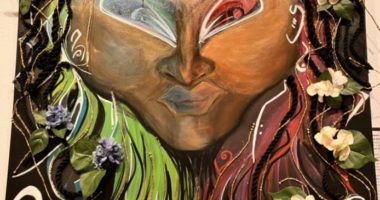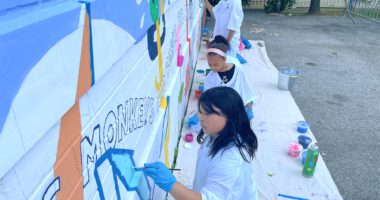Standing outside of the classroom doorway, I braced my nerves for a brand new experience: presenting my very own lesson plan in a public school for the first time. I ran through my mental checklist for what must have been the hundredth time. I had coffee and meditated, I had my worksheets and materials with me, I reviewed my lesson plan over and over. I felt as ready as I could be, reminding myself to take some deep breaths and slow down as the time inched closer.
I was in a bit of a different situation than my Teaching Artist Training & Internship Program (TATIP) peers, as I had been the sole trainee to work with my particular classroom throughout my P.S. 316 residency. This meant that, where most of my fellow TATIP trainees were presenting their lessons with their residency partners, I got the chance to execute mine with one of my mentors, Katie Issel Pitre. This was slightly intimidating, given that she was much more experienced at this than I was, but also a fantastic opportunity for growth and guidance.
Taking one more deep breath, I pushed open the door, greeting this crowd of children I had become so fond of over the past weeks. In their bright yellow school uniform shirts, the students’ upturned faces reminded me of a sea of sunflowers looking my way. Katie and I called them to stand up and launched right into Che Che Kule, keeping the consistency of the opening ritual that my mentors use for all of their lessons.
Next, we all gathered on the rug at the front of the classroom, arranging ourselves into some semblance of a circle. I asked the students who was familiar with yoga, and was surprised to see several hands fly into the air. Upon asking them to elaborate, I was told that it “helps you relax” and “makes you stretch.” We went through a simple deep breathing exercise with our eyes closed to bring our focus internally, and then I began demonstrating the first pose, a Cat / Cow sequence. On my hands and knees, I showed the students how to inhale and lengthen their spines, lifting their faces to the sky, and then exhale and round their spines, hunching inwards. After a few breaths, I instructed them to pass the pose around the circle one by one, passing it off to the student on my left.
To my dismay, the pose zoomed around the circle. The students seemed to be embarrassed to be put on the spot individually, flailing and wriggling through the spine lengthening and rounding as quickly as possible. I realized that I would need to adjust my plan. As poet Innocent Mwatsikesimbe wrote, “It’s not the surprise that matters, it’s how you react to it”. We stopped to have a brief discussion about how they felt acting as the cat and the cow, and what they would have said in their animal voices. I reminded them about the importance of the breathing, and demonstrated the next pose for them, a backbend called Camel. This time, after the pose had been explained, we all took a collective breath and performed it together as a group, our hands on our hips and hearts opening upwards. We also kept our eyes closed so that we could truly feel the experience in our bodies.
Keeping this same pattern for the final pose, I displayed the forward fold Rabbit, curling into a ball with my head on the ground in front of my knees. After we enacted the pose as a circle, Katie once again led us into a discussion about the emotions that arose from moving through these postures, and what these animals were thinking. We heard that Camel made us “feel silly,” and that a few of our Rabbits were “scared” or “hungry and munching food on the ground.”
For the main portion of the lesson, we had the students return to their desks and distributed worksheets for brainstorming. I wrote out the word “personification” on the board while Katie asked them what word was embedded within that larger word. Katie went on to define this word and give some examples, asking, for instance, what their desks would say to them after working with them for this entire school year. The worksheets had pictures of each of the four animal poses that we had portrayed, as well as the Mother Goose poem “Hey Diddle Diddle” and some question starters (What would your animal ask you about being a first-grader at P.S. 316? How does your animal feel about having a human friend?).
This part of the lesson, ironically, went even more smoothly than I had imagined. All of the preparation and the yoga activity synthesized wonderfully with Katie’s vivid descriptions of personification in action. The class really appeared to grasp the concept, and were enthusiastic about circling their favorite animal and completing the question prompts. After some time had been spent on this individually, we called on a few volunteers to share their answers, which they were more than eager to do. Finally, we closed out the lesson with the traditional activity my mentors use, the Peace Power chant.
It was a whirlwind of an hour that left me feeling like I had learned as much as I had taught. The main thing I will take from the experience, in the words of Aristotle, is that “He who cannot be a good follower cannot be a good leader”. Although I was initially very nervous, I had to be receptive to the cues the class was giving me about what was successful and what was not. It is vital to maintain the ability to listen and adapt accordingly, thus remaining open and able to enjoy the moment.

-Megan Skelly, Writer, TATIP Trainee



